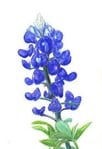
What does winter freeze have to do with blooming flowers?
How is that connected to our lives of faith?
One of my favorite hobbies is gardening. I love cooperating with nature to produce something beautiful like a field of wildflowers, a vegetable garden, or a grove of oak trees that can be enjoyed for many generations. Some missionaries I know of have the added advantage of using a garden project not only as a pastime or a supplement to their food supply, but also as a way to raise income for their mission. But for me it is mostly a way to relax and enjoy the bounty of the Earth.
When it comes to planting wildflowers, my absolute favorites are the Texas Bluebonnets. This state wildflower puts on an annual showy blue carpet of blossoms across roadsides and meadows for several days during springtime. After a winter that is barren, new life comes during March and April. For me, this lovely seasonal example of God’s beauty in creation is also a sign of the Resurrection during the Easter season: new life in Jesus Christ who was crucified and died for our sins but has risen from the dead. Alleluia! (Luke 24:46-47)
Other seasons of the year besides spring are just as significant if there is going to be an Easter show of bluebonnet flowers. We all know that winter has its own special beauty with its cold and silent nights. It’s during these fallow times that the bluebonnet seeds, released when the blossoms are spent, must have their hard seed shell cracked by the pressures of temperature changes during a winter freeze. If there is no cold snap to break the hard coating (or the gullet of a bird to grind it up and then release it), then there will be no new bluebonnets. The seed’s passage from breaking/dying to flower/rising is symbolic of our lives when we enter into the Christian mystery of suffering, death and resurrection.
St. Paul reminds us many times that it is only by dying that we can live in the newness of life (Romans 6:3-11). He writes in his letter to the Colossians (3:1-4): “…you have died and your life is hidden with Christ in God.” What the greatest of all missionaries is teaching us is that if we want to encounter Jesus, then we have to die to whatever keeps us from Him. We cannot be slaves to darkness if we want to enter into the light of Christ.
Paul mentions some major stumbling blocks to Christian faith throughout the Scriptures, and I’d like to touch on a few of them here. We know that sin is a part of our human condition and we are tempted to do what is contrary to the love of God and the love of neighbor. For those who are trapped in the vise of sin, the only remedy is to call on the Lord for help in giving up what is not bringing life. With God’s grace, any conversion from sin is possible. But you have to let the hard shell of selfishness and sin be cracked and let your old self die so that you may live for others and blossom the way God intends for you.
Don’t let the following sins keep you from life on high (2 Timothy 3: 1-4). Paul mentions that egotism, greed, pride, arrogance, abuse, etc. will keep us from the light. These things rob you of the fullness of life and keep you from a deeper encounter with God. You are not flourishing or flowering if you engage in these vices. Contrarily, you know you are blooming when you experience moments of faith, hope, love, patience and steadfastness. Not only can you feel the joy of Easter when immersed in these virtues, but others will benefit from your life also.
God is at work in us whether we are in the spiritual season of spring, winter, summer or fall. We will flourish as human beings in the same way that nature brings forth new life during springtime. But this happens only after a dying to whatever hardness of heart keeps us from the Lord. Today’s Good News is that Jesus’ Resurrection is more powerful than sin, suffering or death. Alleluia!
MISSIO offers themed-quizzes in MissioBot to examine your religious knowledge - and this blog by Father Leo Perez, OMI to reflect on questions of mission and faith.




